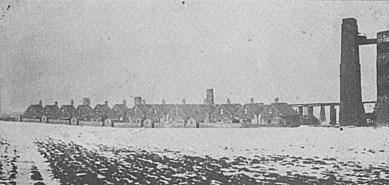 |
Watson Town (1869-1900) |
[from the original by Tom McNee]
John Watson was born in Weardale and worked as a young man at Washington Chemical works, where he worked his way up to the position of general manager.
In 1863 he and his partners, Francis Kipling of Sunderland, and John Petrie of Rochdale came to Seaham, took 16 acres of land on a 99 year lease from the Londonderrys, and built Seaham Chemical Works. Two years later, the firm began trading, chiefly in soda crystals and magnesia. One shipload per week was sent to markets in London and Ostend in the steamship 'Lily'. For twelve years profits were good and were largely invested in more buildings until £80,000 (millions in today's currency) had been expended. At peak, 300 men were employed and a reading room was provided for workers, many of whom lived in a tenemented street of thirteen houses known as Watson Town. This street was situated between the Chemical Works and Blast Furnaces which had been leased from the Londonderrys in 1869: these worked very intermittently, and proved more of a running sore than a good investment.
|
||
[photo from "Seaham Harbour,
the first 100 years, 1828-1928", Tom McNee & David Angus, 1985] |
In 1877 following a year of poor prices and over-production
the firm was £23,000 in debt to the bank and the two partners Watson and
Petrie (Kipling had died) were at a standstill for want of further capital.
To raise capital the private company was turned into a limited company and £20,000
was raised, but further trading losses saw the company going into liquidation
in 1881. Jas B. Petrie, son of one of the original partners, tried again to
revive the fortunes of the works, but, following a disastrous year in 1884 when
prices slumped from £3.5.0 per ton to £2.6.0 per ton, thus causing
a weekly loss of £200 in income, production finally ceased at Christmas
1884. A year later the firm was finally declared bankrupt: under the terms of
the mortgage, the Londonderries claimed buildings and site, which were then
put up for auction, but no one offered to buy. The Chemical Works buildings
and the Blast Furnaces stood gradually deteriorating in wind and weather until
1900, being demolished to make way for the sinking of Dawdon Pit. Watson Town
survived a little longer as it was occupied by the German Pit Sinkers. Vane
House became the home of Dawden Pit Managers until the second world war. It
survives to this day [written in 1987] in use as offices and colliery control
rooms.
John Watson, meanwhile, had retired in 1881, but continued to live at Vane House,
where he devoted the remainder of his life to the study of astronomy. He was
a leading light in the United Methodist Chapel (in Church Street) but also had
a Private pew in St John's Church. He was also a member of the Local Board of
Health (forerunner of the Urban District Council). He died on Novenber 3rd 1885,
and was the first person to be buried in Seaham's new Princess Road Cemetery,
in ground newly consecrated by the Bishop of Durham. The services in the United
Methodist Church had been conducted by circuit ministers, but at the cemetery
service Vicar J. Colling and his curates J. Wallis and T. Copley took over.
In 1986 the headstone was cleaned and re-engraved by the local monumental sculptor
at his own expense because, being the first grave in the cemetery, it is the
one most inspected by visitors.
Thanks: Mary Latham, Brenda Harrison